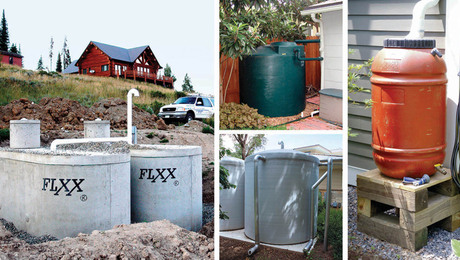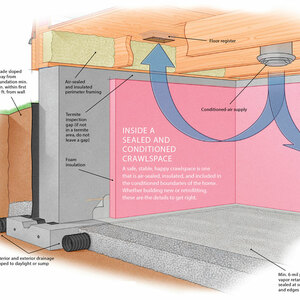Our house sits at the bottom of a hill, and has suffered for years from a wet crawl space. The ground drops about two feet from the back to the front of the house, and then there’s another two foot drop before the retaining wall in front of the sidewalk.
On one side of the back, our son dug a trench and laid PVC line in gravel, the whole wrapped in filter fabric, some years back. As part of our backyard remodel, we wanted to finish the other side; the landscaper who did the design work recommended a flexible pipe wrapped in filter fabric – looks like a snake wearing a black turtleneck to an art opening. This has been laid in the backyard, up to the fence line at the front, and we’re getting ready to finish the trench and take the drain water under the sidewalk. This designer’s technical knowledge gaps became increasingly visible as the project went along, so I’m now wondering: should I be using this flex pipe all the way out front, or should I be transitioning to solid pipe to carry the water to the front? Any special tricks to capping this stuff off and making connections from one section to another?
Bill Houghton, struggling to keep up with the work here…


















Replies
Don't overthink it. I've had that black flexible stuff off my gutters for three years now, and haven't even bothered to bury some of it. It's alot tougher than it looks. I've tripped over it, dropped things on it, stepped on it, weed-ate it, my dog has tried to dig a hole in it, and it is holding up just fine. I prefer the non-vented to the vented kind. I'm not trying to water my drainage line, but move the water away from the house. Its called a curtain drain, by the way, and the only problem I see with the landscape pipe is the couplings and fittings you use aren't necessarily water tight. I used expanding foam in the fittings to waterproof them, but you MIGHT could use pvc couplings and glue. I'd almost bet that the outside diameter of the landscape pipe and pvc are the same. The next time you go to the home center, take a coupling over to the landscape pipe and see if it fits.
Edited 7/20/2008 2:11 pm ET by arcflash
Edited 7/20/2008 2:12 pm ET by arcflash
Your description of the project is a little hard to follow. You could even just draw it out on a piece of paper and then take a picture of it and then post the pic. I think we get the general idea though.
Regarding foundation drainage systems, generally the perforated lines are used for the "collector" lines - I guess you could call 'em, where as solid pipe is used for the drain tail that takes the water away from the area you are trying to keep dry. This drain tail really needs to exit to daylight if at all possible. A perforated line can serve as a drain tail, especially if it has the sock on it.
Regarding the black flexible pipe, although rigid pipe is superior, as it flows better and is less likely to clog due to it smooth inner surface, the flex pipe can perform well for years provided it is installed properly. The main down side is that if the black flex pipe does not have enough cover dirt - say at least 1' and is subject to vehicle traffic, it can crush - sometimes easily if, say, it only has a few inches of cover dirt.
Regarding the flex pipe connections, I like to use couplings and I use small sheet metal screws installed with my cordless drill to make sure they hold together. Really though I tend to over do things, and if the pipe stays connected while it's being buried, it's not gonna come apart.
In summary, I'll say that the way your son did it is actually the best method, but I'll also say that if you wanted your landscaper to do it that way he would have to charge you more money because it takes more labor and more expensive material. Again, your landscaper's method is fine assuming he is covering the sleeved pipe with gravel or crushed stone in the collector area and assuming that the pipe is protected with enough cover dirt elsewhere so as to not be crushed.